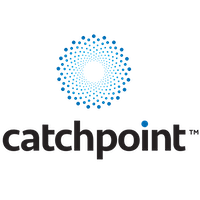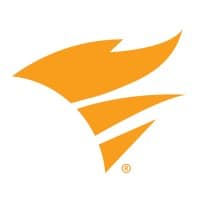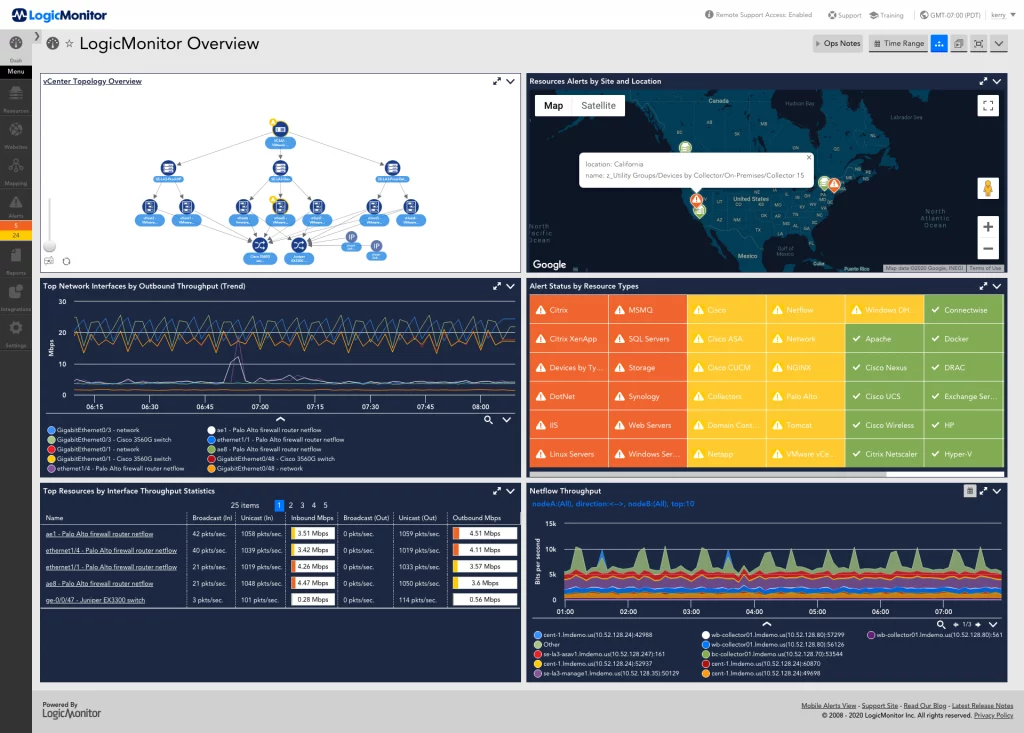Network monitoring is where business performance meets cybersecurity, making it a critical component of any organization’s development, security, and operations (DevSecOps) pipeline.
With the rise of enterprise networks in the past few decades – and evolution in recent years with the addition of virtual, cloud, and edge networks – monitoring tools are as important as ever. Monitoring network traffic across the hybrid IT environment in most organizations today is essential to proactive network management. Whether it’s detecting a behavioral abnormality, bandwidth hog, responding to a novel threat, or using historical data to map trends, monitoring tools will remain essential far into the future.
This article looks at 15 of the best network monitoring tools and what to consider when evaluating monitoring solutions in 2022.
Best Networking Monitoring Tools for 2022
- Auvik
- Broadcom
- Catchpoint
- Datadog
- Dynatrace
- Extrahop
- Kentik
- LogicMonitor
- ManageEngine
- Nagios
- Paessler
- Progress
- SolarWinds
- VIAVI Solutions
- Zabbix

Auvik
Auvik is a fast-growing network management software company offering tools like IT asset management, traffic analysis, and performance monitoring through its cloud-based solution. Clients can choose between Auvik’s Essentials and Performance plans, both of which offer unlimited users, network sites, endpoints, and support. The Essentials plan covers monitoring and alerting, but larger companies will appreciate Performance’s additional tools for forensic traffic data, ML-powered application visibility, and network flow analytics.
On Gartner Peer Insights, Auvik holds an average score of 4.8 / 5 stars with 23 reviews for the Network Performance Monitoring market. Reviews highlight the ease of setup and integration with standard APIs, component monitoring capabilities, and intelligent network traffic analysis.
Auvik Features
- AES-256 encryption for data at rest and TLS v1.2 encryption in transit
- Tools for remote management, global dashboards, and geo IP tracking
- Access to 24×7 DevOps team for technical support and remediating active threats
- Logical secure access including role-based access control, 2FA, and SSO
- Automate configuration backup and recovery for resilient policies and controls

Broadcom
Assembled by Broadcom subsidiary CA Technologies, DX NetOps offers network visibility and actionable intelligence for monitoring digital user experiences. Broadcom’s extensive IT solution stack includes a handful of AI-powered observability products for operational intelligence, management of application performance and unified infrastructure, and network monitoring. Given the bundling potential between Broadcom’s monitoring services and Symantec‘s broader cybersecurity suite, AIOps is worthy of consideration.
On Gartner Peer Insights, Broadcom holds an average score of 4.5 / 5 stars with 75 reviews across the IT Infrastructure and Network Performance Monitoring markets. Reviews highlight product capabilities like endpoint monitoring and topology mapping and the availability of third-party resources.
Broadcom Features
- Continuous feedback loops for improving data management across DevOps
- Monitoring for mainframes, networks, infrastructures, apps, and digital experience
- Dashboard with analytics for services, alarms, logs, and performance metrics
- Network monitoring for cloud, SD-WAN, and traditional core networks
- Service orchestration and automation for complex IT environments
Read more: Best SIEM Tools of 2022

Catchpoint
Catchpoint launched in 2008 as a dedicated monitoring tools provider right as organizations started to dabble with cloud services. Today the NYC-based vendor is on a mission to monitor the end-to-end digital experience of hybrid network users through its Catchpoint platform. Clients can choose individual monitoring solutions for endpoints, networks, synthetic monitoring, and real user monitoring (RUM) or bundle with the Catchpoint platform.
On Gartner Peer Insights, Catchpoint holds an average score of 4.7 / 5 stars with 108 reviews for the Network Performance Monitoring market. Reviews highlight the quality and timeliness of technical support, ease of deployment, and service delivery monitoring capabilities.
Catchpoint Features
- Visibility into third-party providers, local ISPs, CDNs, APIs, and DNS
- Global synthetic monitoring via cloud, wireless, broadband, last-mile nodes, and more
- Actionable alerts, reports, and data insights for reducing MTTR and MTTD
- Protection against DNS cache poisoning, DDoS attacks, and BGP route hijacking
- Monitor workforce VPNs to evaluate performance, reachability, and security

Datadog
Not just an adorable logo, Datadog offers robust solutions for monitoring, performance metrics, and alert notifications for today’s IT environments. Founded in 2010 by veteran SaaS and DevOps industry leaders, Datadog specializes in optimizing the service-oriented architecture, helping organizations monitor user journeys and explore service relationships. Administrators can group traffic by container, team, or office and filter data by tag, device, or host.
On Gartner Peer Insights, Datadog holds an average score of 4.5 / 5 stars with 211 reviews for the IT Infrastructure Monitoring Tools market. Reviews highlight the interactive dashboard, level of customization, troubleshooting, and ease of use and implementation.
Datadog Features
- Visibility across on-premises, IoT, digital experience, cloud, and hybrid networks
- Isolate and troubleshoot network issues and identify high traffic teams
- Visualize network traffic across data centers, containers, and applications
- Integration metrics for determining issues lying with a cloud service provider
- System-wide DNS performance and health tracking with multiple indicators

Dynatrace
Dynatrace offers a full-stack application performance monitoring and digital experience platform for modern hybrid environments. With Dynatrace, administrators can access infrastructure monitoring features for entity relationships, behavior, logs, metrics, and vulnerability profiles. Built-in capabilities include optimizing KPIs and user experience, process automation, and enriching DevSecOps communication and collaboration.
On Gartner Peer Insights, Dynatrace holds an average score of 4.6 / 5 stars with 90 reviews across the IT Infrastructure and Network Performance Monitoring markets. Reviews highlight monitoring capabilities for servers, storage systems, and databases and the availability of third-party resources.
Dynatrace Features
- Change tracking to monitor new machines and network devices automatically
- Track inbound and outbound process connections through a network interface
- Root cause analysis to determine the impact on customer experience and remediate
- Capacity planning by identifying resource-intensive processes at host and process level
- Health metrics like RAM, CPU, disk, and network health in a single dashboard
Also read: Top Cybersecurity Startups to Watch in 2022

Extrahop
ExtraHop is the cloud-native cybersecurity vendor specializing in monitoring today’s hybrid workloads and the latest network detection and response (NDR) solution. Through the Reveal(x) 360 platform, clients can optimize visibility across core, remote, edge, and cloud deployments, detect threats in real-time, and automate investigation workflows. With Reveal(x) Advisor, organizations can have an on-demand analyst help with deployment, application mapping, and SOC or risk optimization.
On Gartner Peer Insights, Extrahop holds an average score of 4.8 / 5 stars with 133 reviews for the Network Performance Monitoring market. Reviews highlight responses to product questions, quality and availability of end-user training, and product capabilities like IT operations analytics and diagnostics.
Extrahop Features
- Identify and deploy Reveal(x) to monitor hybrid or multi-cloud networks of choice
- Machine learning for behavioral analysis and investigation of network traffic
- Cloud-based record warehouse with search, query, and drill-down investigations
- Cloud service provider packet mirroring for agentless visibility and granularity
- Tools for digital forensic, incident response, compliance, and threat hunting

Kentik
The youngest of companies picked for this year’s list, Kentik has been a budding networking monitoring vendor since 2014. The Kentik Network Observability Cloud includes a bundle of network tools for ingesting, enriching, and integrating traffic across the hybrid IT environment. Kentik’s solutions can protect core, edge, and cloud networks while adding DDoS and botnet protection, supply chain analytics, and synthetics.
On Gartner Peer Insights, Kentik holds an average score of 4.8 / 5 stars with 94 reviews for the Network Performance Monitoring market. Reviews highlight the quality of technical support and vendor responsiveness, seamless onboarding, and meaningful data visualizations.
Kentik Features
- Access to a continuously updated multi-source threat intelligence database
- Detect and neutralize DDoS attacks and automate mitigation processes overtime
- Analyze real-time and extensive historic data for troubleshooting and forensic analysis
- Built-in security with application segmentation, MFA, and encryption at rest and in transit
- Track RPKI to detect leaks, prevent hijacking, and validate secure traffic routes for BGP

LogicMonitor
LogicMonitor is an industry-recognized name offering its cloud-based infrastructure monitoring platform for applications, databases, containers, servers, storage, logs in context, and more. The LogicMonitor Pro core package comes with essential tools for hybrid infrastructure monitoring, including intelligent alerting, topology mapping, and extensive integrations. For organizations covering 200+ devices, LogicMonitor Enterprise supports the NBAR2 protocol, dynamic services monitoring, and anomaly detection.
On Gartner Peer Insights, LogicMonitor holds an average score of 4.8 / 5 stars with 93 reviews across the IT Infrastructure and Network Performance Monitoring markets. Reviews highlight ease of deployment, component and service delivery monitoring, and flexibility with customization.
LogicMonitor Features
- Access to 2,000+ preconfigured integrations like Azure, ServiceNow, and Oracle
- Role-based access control and robust user authentication controls like 2FA and SAML
- Sandbox for testing custom modules before deploying to environments
- Synthetic transaction coverage with ping checks, multi-step tests, and service checks
- SOC2 Type 2 standards and ISO/IEC 27001:2013 certified platform
Read more: Best Intrusion Detection and Prevention Systems

ManageEngine
ManageEngine offers over 110 products and tools, including monitoring solutions for application performance, servers, and networks. The ManageEngine OpManager Plus includes a bundle of tools for bandwidth and traffic analysis (NetFlow Analyzer), networking performance monitoring (OpManager), and tools for firewalls, IP addresses, switch ports, and configuration policies. A part of the ManageEngine family, Site24x7 is another solution with APM functionality, web application monitoring, website performance, and remote monitoring and management (RMM).
On Gartner Peer Insights, ManageEngine holds an average score of 4.5 / 5 stars with 682 reviews across the IT Infrastructure and Network Performance Monitoring markets. Reviews highlight granular visibility on the dashboard, custom notification policies, quality of technical support, and user profile management.
ManageEngine Features
- 2,000+ built-in network performance monitors to track critical metrics and health
- Multi-level thresholds for customizing network performance expectations and alerts
- Monitoring for latency, RTT, packet loss, hop-by-hop performance, and more
- 200+ performance widgets available to customize the administrator dashboard
- Support for virtual (VMware, Xen, Nutanix) and physical (Windows, Linux) servers

Nagios
Nagios offers enterprise monitoring capabilities, but it’s perhaps best known as one of the most popular open-source network monitoring solutions. Nagios’ extensive solution set covers monitoring for websites, protocols, operating systems, servers, power, email, and more. For additional support and advanced features, clients can choose between Nagios XI for infrastructure monitoring, Nagios Fusion for managing multiple global locations, a log server for traffic data discovery, or a network analyzer for bandwidth monitoring and flow analysis.
On Gartner Peer Insights, Nagios holds an average score of 4.4 / 5 stars with 235 reviews across the IT Infrastructure and Network Performance Monitoring markets. Reviews highlight continuous monitoring capabilities for servers and networks, interface configuration, product support, and capacity planning.
Nagios Features
- User-friendly web GUI for customizing layout and preferences for individual users
- Access to multiple APIs for integration with in-house or hundreds of third-party addons
- Integrated capacity planning insights for proactively upgrading legacy systems
- Alert escalation policies for ensuring stakeholders remediate detected threats
- Monitor and manage distributed operations servers for clients’ remote locations

Paessler
The PRTG Network Monitor is Paessler’s widely known network monitoring software. The vendor’s flagship solution covers hybrid IT environments for SMB organizations across systems, traffic, devices, and applications. For larger organizations, the PRTG Enterprise Monitor can monitor thousands of devices for a distributed environment offering auditable data collection and service-based SLA monitoring through the ITOps Board.
On Gartner Peer Insights, Paessler holds an average score of 4.6 / 5 stars with 530 reviews across the IT Infrastructure and Network Performance Monitoring markets. Reviews highlight the ease of deployment and use, component monitoring, IT operations analytics, and historical data retention.
Paessler Features
- Flexible notifications options for stakeholders, including email and HTTP requests
- Real-time mapping and auto-discovery of network components for administrator visibility
- Monitor distributed networks by installing remote probes with a hosted PRTG license
- Automatic failover handling between a primary master within a node cluster
- 250+ preconfigured sensors for customizing IT infrastructure monitoring
Also read: Top MDR Services and Solutions

Progress
Four decades after its launch at MIT, Progress Software offers an impressive stack of IT business applications and an industry-leading infrastructure monitoring solution in WhatsUp Gold. Progress WhatsUp Gold comes with a bundle of tools for network mapping, application performance, and log and configuration management to streamline network monitoring workflows and reduce MTTR.
Progress also boosted its monitoring prowess with the acquisition of Kemp Technologies in September 2021, adding budding network performance monitoring vendor Flowmon under its umbrella of solutions. Flowmon offers anomaly detection, volumetric attack detection, data storage, and traffic analysis for security operations capabilities.
On Gartner Peer Insights, Progress and Flowmon solutions combine for an average score of 4.5 / 5 with 108 reviews for the Network Performance Monitoring market. Reviews highlight product capabilities like auto-discovery, mapping network diagrams, and adequate notifications.
Progress Features
- Customize failed state policies and automate switch to backup with failover manager
- Monitor a range of network components, including routers, wireless, virtual, and storage
- Options to alert stakeholders by web, email, SMS, or Slack for prompt remediation
- ML-powered threat detection for anomalous traffic between perimeter and endpoint
- DDoS protection with mitigation tiering and dynamic threshold adjustment

SolarWinds
Despite the news of a sophisticated attack in December 2020, SolarWinds solutions continue to be a top consideration for monitoring and performance tools. The Austin-based IT vendor serves 99.6% of the Fortune 500 with its enterprise monitoring and management tools for networks, systems, databases, services, applications, and security. SolarWinds gives clients plenty of options to buy tools like configuration management, device tracking, topology mapping, and log analysis as standalone products or bundles.
On Gartner Peer Insights, SolarWinds holds an average score of 4.4 / 5 stars with 670 reviews between the IT Infrastructure and Network Performance Monitoring markets. Reviews highlight service delivery monitoring, diagnostics, and ease of implementation and configuration for large-scale environments.
SolarWinds Features
- Performance monitoring for applications, VMware hosts, servers, and networks
- Investigate log and event collection data to identify the root cause of issues
- Automate monitoring, traffic analysis, and change management for hybrid networks
- VoIP monitoring for WAN performance insights and QoS metrics
- User device tracking, IP address management, and trend analysis
Read more: Best Identity and Access Management (IAM) Solutions

VIAVI Solutions
Spun off from the telecommunications vendor JDS Uniphase in 2015, Viavi Solutions is a newer name, but it has four-plus decades of IT services experience. In 2022, the Arizona-based vendor specializes in network performance monitoring and threat analysis with its Observer platform. Observer products include integrating environment traffic, data analysis, threat detection and response, and robust, on-premises appliances.
On Gartner Peer Insights, Viavi holds an average score of 4.8 / 5 stars with 79 reviews for the Network Performance Monitoring market. Reviews highlight the vendor’s ability to understand client needs and quality of technical support and product capabilities like utilization metrics, data visualization, and endpoint monitoring.
VIAVI Features
- Tools for network security forensics, root-cause analysis, and line-rate packet capture
- End-user experience (EUE) analysis for every network transaction
- Passive, full-duplex network TAPs for copper, aggregation, conversion, and optical
- Unified communication analysis for app performance, trends, and troubleshooting
- Role-based access control with the Observer Management Server (OMS)

Zabbix
First released to the open-source community in 2004, founder Alexei Vladishev formally launched Zabbix the year after to develop and extend the solution’s capabilities to an enterprise audience. The Latvia-based company now has offices on four continents, and its namesake solution comes with a long list of features for deployment, integrations, service monitoring, and data visualization. Zabbix’s enterprise security capabilities include configuration change tracking, secret vaults, flexible permissions, and encryption between all client devices.
On Gartner Peer Insights, Zabbix holds an average score of 4.5 / 5 stars with 284 reviews for the IT Infrastructure Monitoring Tools market. Reviews highlight the quality of the peer user community, monitoring capabilities for networks and servers, and ease of use and customization.
Zabbix Features
- Determine business-level impact with root cause analysis and SLA monitoring
- Collect metrics and analyze cloud services, log files, databases, apps, and IoT sensors
- Protect sensitive data access by defining metrics allow and deny lists
- Threat detection with machine learning, trend prediction, and smart thresholds
- Install in minutes for on-premises or cloud networks with component discovery
What are Network Monitoring Tools?
Networking monitoring tools are software applications or hardware appliances designed to help network administrators maintain consistent visibility into historical and real-time traffic of on-premises, cloud, virtual, and edge networks and their components.
Network monitoring considers standard network components’ behavior, traffic, and health, like endpoint devices, firewalls, routers, switches, and servers. Administrators can use network monitoring tools to enhance visibility and deepen performance control, fault tolerance, and system or account activity.
Network Monitoring Software Features
- Detect and diagnose network-specific incidents for resolution
- Establish network performance baselines for regular auditing
- Track network performance, activity levels, and trends in downtime
- Visualize network performance and trends with graphical tools
- Record, document, and analyze historical and real-time events
- Identify network devices and systems for continuous visibility
- Control alert policies to notify stakeholders of abnormal activity
- Use actionable data to pinpoint needed remediation

Monitoring Solutions: Network vs. Application and Database
Monitoring IT systems is as essential to cybersecurity as solutions come. Today’s marketplace includes various options for curated monitoring tools for databases, applications, networks, and more.
Database monitoring like SQL server monitoring has long been used to track data flow in enterprise systems. In contrast, application performance monitoring (APM) is the latest solution to address how users interact with applications and the increasingly complex application ecosystem.
Together, monitoring solutions for databases, applications, networks, and specific IT systems complement and are crucial to visibility across an enterprise environment.
What is Network Detection & Response (NDR)?
In the evolution of endpoint security solutions, endpoint detection and response (EDR) and its managed version (MDR) are all too familiar. Today, the emergence of XDR has overshadowed a crucial component of the comprehensive solution – network detection and response (NDR).
NDR goes beyond traditional EDR in monitoring, detecting, and responding to threats for internal networks. NDR solutions typically offer administrators visibility and control for insider threat detection, user behavioral analysis, and more.

